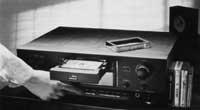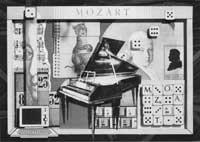The revolution of numerical music
Any music lover will certainly recognize today that the best sound quality of listening is obtained by compact discs. Aside from live concerts, there is nothing like listening to music read with lasers. In the last ten years silver plated cymbals have absorbed 80% of the plastic discs market and sold in total about one billion units a year.

But the compact disc so far has an obstacle. It can only be read. You can listen to the music you have recorded, but you cannot remove and record another. However, from now on you can also do this, recording and listening to the music you want, with laser quality.
On devices that have now been released by Philips and Sony, they use compression systems to record information and in addition to music data, other types of data can be recorded: names of singers, titles, sometimes lyrics of songs, etc.
Erasable numeric music
The truth is that the era of hearing recording devices began poorly. In 1987 Sony released the Digital Audio Tape (DAT) to record and read numerically the booths. Besides being very expensive, you can not read the usual analog huts. In addition, it has rotating head to read the booth and as in the video magnetoscope the tape should be collected around a few axes and rollers (just like you have to put the thread to the needle) every time you get (and drop each time you go out). Therefore, copies of the casetas cannot be removed at high speed and the system has been discarded.
Two new systems
However, Philips launched last autumn the Digital Compact Cassette (DCC). It has an audio-numeric reader with fixed head, can read conventional analog huts and 100,000 ptas. (5,000 pounds).
Sony, for its part, has announced its Minidisc (MD) model in similar times and at similar prices. It is a compact laser disc that can be erased and re-recorded. You can receive the same information as the traditional CD (music of 74 minutes), but its size is five times smaller.
In the competition between these two gigantic houses they have prepared very different systems for reading and recording music. Philips has selected a booth where the tape should not be collected at first and Sony has selected a erasable laser compact. The only common point of both systems is the numerical encoding of sound.
Numerical sound encoding

The numeric sound allows the music to be heard clearly without background noise or distortion, without the signal deteriorating for a long time. In the numerical system the sound signal is encoded by a succession of units or bits in state 0 or 1. In the numerical magnetic caset, states 0 and 1 correspond to the northern and southern polarities in the magnetized particles divided into ribbons, and in the laser disc to the launas and holes. This system seems rather clumsy, but it keeps the signal much better than the analog system, since in the last mentioned system there is friction in the reading head and background noise is received. In plastic discs there is also friction in the grooves and wear out over time.
In the numerical recording system, both in the DCC model and in the MD model, sound is analyzed in very short time intervals (48 milliseconds per second). The amplitude of the signal becomes a 16-bit message and theoretically it is possible to record 64,000 amplitude levels. Multiplying is calculated that to record a music of 75 minutes it takes three billion bits. Due to the resolution limitation imposed by the subsequent reading system, it is not possible to have so much information on a small disc or cassette. Therefore, Philips and Sony have prepared information compression systems called PASC (Precision Adaptive Sub-Coding) and ATRAC (Adaptive Transform Acoustic Coding), respectively. These systems allow to eliminate between 75% and 80% of the information without just modifying the sound reproduction quality.
Sony System
From there, Philips and Sony systems look nothing like it. On the Sony device there are two procedures. One is to read the already recorded compacts and the other to record the simple compact (virgin). The first procedure is exactly the same as before. The laser beam is reflected in the launas and holes in the engraved disc. In moments of sauna is reflected with great intensity and when the hole is found the reflected ray is more dispersed. A photoelectric cell interprets the reflected ray by emitting the signal 1 or 0.
The Japanese manufacturer has presented a true innovation in its system of elimination and registration of information in its miniconduit. The disc is not recorded, but has in its thickness a variable magnetic layer with a magneto-optical system. In addition to the laser head, on the other side of the disc has a symmetrical magnetic head. The operating base is the possibility of temporarily demagnetizing the magnetic layer when heated. The laser beam heats the disc up to 180ºC. Since the disc is rotating, the heated point is removed from the heat source and the temperature drops, but the magnetic head is soaked by North or South polarization (1 or 0). The magnetic field consists of a coil located on the head and is crossed by the current modulated by the sound to be recorded.
To read the recorded music, the laser with two photodiodes separates the numerical signals depending on the polarity of the reflected wave. The polarization of the reflected wave also depends on the orientation of the magnetic field that has reflected it.
Philips system
To achieve the reading head of any type of booth, both analog and DCC or numerical, Philips has made a special effort in miniaturization. At the same point, twenty microburos are collected in their apparatus. The “largest” are the two analog reading heads measuring six tenths of a millimeter each. The numerical heads are eighteen (nine to record and nine to read). They only measure 18.5 and 7 hundredths of a millimeter. The sound signal on the tape is recorded in eight parallel tracks and the ninth is available for the identification of the sections.
Rivalry

Both houses have launched their products at the same time, which is causing a strong rivalry between buyers. Considering that the current compact discs are mainly heard in rooms and rooms, Sony has portable devices (car, etc.) proposes but the Philips house starts to remove fixed DCC appliances for the classroom.
Sony has installed a shockproof system to prevent the laser head from moving when it is not needed (because the car has entered a hole).
Regarding the duration and quality of the music, there are small differences between the MD and DCC systems. This is a magneto-optical reading on Sony's MD system that, since there is no physical friction, can be expected to last the same length as the current compact disks. In the Philips DCC model the duration has to do with the reading frequency, but they say that the normal use is about ten years. However, the signal that is recorded is compressed somewhat less and the sound quality can be somewhat better.
Another field of competition, perhaps the main one, is that of the houses that record music. And there are recording houses that can choose between the MD system or the DCC system and that certain singers can only be heard in one of these systems.
Buletina
Bidali zure helbide elektronikoa eta jaso asteroko buletina zure sarrera-ontzian











